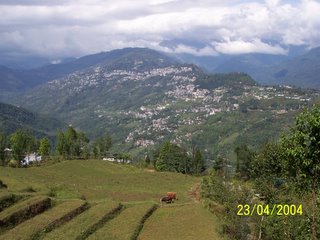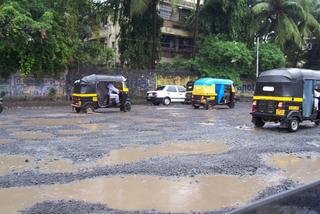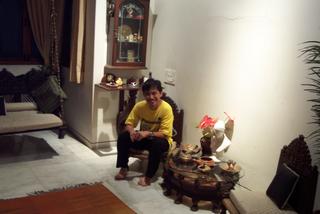Tuesday, July 15, 2008
Melaka - UNESCO's World Heritage?
How Melaka became an UNESCO's World heritage? In what angle they look at? What have they seen now and before? Melaka should never become a world heritage city. Historic sites have never been protected. What had started Melaka back hundreds of years ago even before the invasion of Portuguese in the year 1511. Melaka was a trading centre for the east and the west to meet. The Arabian, the Indian and the Chinese were there buying and selling their produce. Where they did it? The river banks of Melaka. One can find in the old photographs and paintings find in the museum and many history books. One can see staircases along the bank for the ‘tongkangs’ and small boats to unload the goods from other parts of the world. It clearly displayed the lifestyle of the people during the glamorous days. These river banks marks the beginning of the ancient world trade centre.
Where are these sights now? I am not talking about the people. It is the staircases, the godowns and the remaining structures of the 'heritage'. Tell you what. They are all beautifully decorated and replaced by concrete pilling into the river and laid new tiles by the side. Plant new trees and build restaurants which look so clean and nice. What the heck is this? The history of the old Melaka, we were so proud about. There is nothing left here really. Unambiguously it is simply a modern city. Very soon we shall see Starbuck sidewalk cafe there. Already there, a gigantic Markota Complex which out shine the real attractions of the historical value one can never replace. Let us ask ourselves, why do we go to Melaka? The chicken rice ball perhaps, but even that it is no longer original.


We still have the Christ Church and the A'famosa. Hey! Those things came after year 1511, a reminder of this land being shamefully invaded by the Westerners. That is fine, it is also history. The disgrace is that they are loosing their shine as well. Grave stones of the ancient Dutch were laid on the floor of St. Paul Church for many years before they were finally leaned on the walls. Too late, we can hardly read some of them (Some blurred one might have thrown away). In Holland, every town has a town hall called 'Studthurs'. In Melaka too it has one, the word was hung on the entrance of the red Dutch house and surprisingly it spelled in an ancient Dutch writing which no longer be used. A disappointed encounter at this red Dutch house opposite the church where this old, old reading was has gone missing but replaced by an electronics digital display. Shameful, embarrassing and angry over the inability of our city council have no competent in maintaining gifted treasures we inherited from time.
UNESCO members think again, are you also such an incompetent people. The world heritage sites in other parts of the world are awaiting you to appreciate and recognise their existence to be passed down to the generations. I doubt your professionalism pertaining to your choice of Melaka a world heritage. I protest ...
Written by S K Goh
10th July 2008
Where are these sights now? I am not talking about the people. It is the staircases, the godowns and the remaining structures of the 'heritage'. Tell you what. They are all beautifully decorated and replaced by concrete pilling into the river and laid new tiles by the side. Plant new trees and build restaurants which look so clean and nice. What the heck is this? The history of the old Melaka, we were so proud about. There is nothing left here really. Unambiguously it is simply a modern city. Very soon we shall see Starbuck sidewalk cafe there. Already there, a gigantic Markota Complex which out shine the real attractions of the historical value one can never replace. Let us ask ourselves, why do we go to Melaka? The chicken rice ball perhaps, but even that it is no longer original.


We still have the Christ Church and the A'famosa. Hey! Those things came after year 1511, a reminder of this land being shamefully invaded by the Westerners. That is fine, it is also history. The disgrace is that they are loosing their shine as well. Grave stones of the ancient Dutch were laid on the floor of St. Paul Church for many years before they were finally leaned on the walls. Too late, we can hardly read some of them (Some blurred one might have thrown away). In Holland, every town has a town hall called 'Studthurs'. In Melaka too it has one, the word was hung on the entrance of the red Dutch house and surprisingly it spelled in an ancient Dutch writing which no longer be used. A disappointed encounter at this red Dutch house opposite the church where this old, old reading was has gone missing but replaced by an electronics digital display. Shameful, embarrassing and angry over the inability of our city council have no competent in maintaining gifted treasures we inherited from time.
UNESCO members think again, are you also such an incompetent people. The world heritage sites in other parts of the world are awaiting you to appreciate and recognise their existence to be passed down to the generations. I doubt your professionalism pertaining to your choice of Melaka a world heritage. I protest ...
Written by S K Goh
10th July 2008
Monday, January 16, 2006
An enchanting discovery of Sikkim
 This intinerary to Sikkim is specially designed in favour of all Malaysians who look forward to high mountains, wilderness, calm, scenic and yet with minimal hassle.
This intinerary to Sikkim is specially designed in favour of all Malaysians who look forward to high mountains, wilderness, calm, scenic and yet with minimal hassle.It is a chance to experiencing the warm hospitality of the Sikkimese.
Just click the links on the right for details.
Thursday, October 20, 2005
Organic food of Sikkim
There are vast varieties of fruits and vagetables found in Sikkim. A land of which made up of mainly mountains. Large rivers carry mountain stream, melted snow and rains thus prividing plenty of unpolluted fresh water. The sami-tropical forest and the rich agricultural land grows almost anything. Fruits and vagetables either growing wild or from the farm use no chemical or fertilizer at all.
I have tasted so many types of organic food, but only some of it were recorded into my digital camera. The cooked vagetable will not be introduced here as they are too many to mention.

Tree tomatoes : Grow freely, can easily be found at the back yard. It taste just like ordinaly tomato. Like its name, it grows on a tree. A true organic vagetable.
Lauka(White Gourd, one that cuts into half), a common farm vegetable found in the market, very fresh.
Cucumber, it looks a little different from ours. Quite large but smell and taste great. The people there eat fresh with salt. You know, it is served in a gethering to the guest. Nice, just like we served water melon. Farm vegetable.

A picture of a tree tomato.

Squah, in pearl white, looks lovely, it is one vegetable that everyone likes. An easily grown vegetable that can be found in any household. Almost the whole plant can be eaten. The fruit usualy cuts into slices and cook with turmerit powder (yellow ginger). grow wild
This picture is decorated with Dalle. Beautiful as its name, but it is a very, very hot chilli. It is also known as Round Cherry Chilli. Farm vegetable.

Nakema (one that in the plastic bag). This is a unique seasonal wild growing plant; very, very bitter. It has good medicated value, especially good for high blood presure people. It may be found in the wild, but it is very expensive. More than RM10 per kg. Surprise isn't it?
Mustard Leaf, A delicious organic food. The seed of this plant is used to make the familiar mustard.
Karela (Bitter gourd), usually very small in size, but it taste very original as compare with ours. Perhaps it is due to free of fertilizer and generic modification.
I have lost some of the pictures, therefore was unable to introduce more to you. Apology...
I have tasted so many types of organic food, but only some of it were recorded into my digital camera. The cooked vagetable will not be introduced here as they are too many to mention.

Tree tomatoes : Grow freely, can easily be found at the back yard. It taste just like ordinaly tomato. Like its name, it grows on a tree. A true organic vagetable.
Lauka(White Gourd, one that cuts into half), a common farm vegetable found in the market, very fresh.
Cucumber, it looks a little different from ours. Quite large but smell and taste great. The people there eat fresh with salt. You know, it is served in a gethering to the guest. Nice, just like we served water melon. Farm vegetable.

A picture of a tree tomato.

Squah, in pearl white, looks lovely, it is one vegetable that everyone likes. An easily grown vegetable that can be found in any household. Almost the whole plant can be eaten. The fruit usualy cuts into slices and cook with turmerit powder (yellow ginger). grow wild
This picture is decorated with Dalle. Beautiful as its name, but it is a very, very hot chilli. It is also known as Round Cherry Chilli. Farm vegetable.

Nakema (one that in the plastic bag). This is a unique seasonal wild growing plant; very, very bitter. It has good medicated value, especially good for high blood presure people. It may be found in the wild, but it is very expensive. More than RM10 per kg. Surprise isn't it?
Mustard Leaf, A delicious organic food. The seed of this plant is used to make the familiar mustard.
Karela (Bitter gourd), usually very small in size, but it taste very original as compare with ours. Perhaps it is due to free of fertilizer and generic modification.
I have lost some of the pictures, therefore was unable to introduce more to you. Apology...
Wednesday, September 28, 2005
A day in Bombay

We took an early morning flight from Calcutta airport. It was packed with business looking people with attaché case in one hand and mobile phone in another. The jet flew through a thick rain cloud, the moment the runway was spotted it was already a touch down. It was raining quite heavily and it has been so for a number of days. The airport road leading to the industrial district took us almost 2 hours instead of just 20 minutes. We had to sail through a road of portholes with a massive traffic jam. About two months ago a great flood had hits the same place, which was the worst in its history. Water marks still clearly appear on the walls at a height of at least ten feet.
We were late for appointment but it was quite accepted due to the rain. The conditions on the road as compared with the business complex show a big contrast. One is modern and the other is many, many years behind time. The infrastructures in India generally quite outdated but its technologies and communications are far more advance then many others including ours. The programmers and engineers are very intelligent. They have made products that I really impressed. We had lunch in a very nice hotel and yet it is only a doorstep away from the bad roads and drains, a world of differences.
Heading to the city was interesting. One could see the changes along the way. The roads get slightly better and better until the high rise buildings were seen. Enter the heart of the city I sometime feel a little like I was in Penang near the Gurney Drive. Some familiar sites were seen as though it was in Singapore. It also gives a feeling of being in a western country. The roads here are much better although they are all cements and stones.
The Marina Drive of Bombay is beautiful, even though it was raining that day, with low dark clouds ahead. The famous ‘Gateway of India’ arch, was built especially for the visit of Queen Victoria, is standing right at the waterfront. From far with the backdrop of the city skyline of tall buildings create a picturesque view. I regretted for not taken any photo because of the rain, and the strong wind that blew from the Arabian Sea.
We had a nice cup of tea and some nice sandwiches at a bistro with good ambient that attracted a lot of foreigners. Bombay is said to be one of the highest cost of living city but the bill came up to be about RM12 – cheap.
Walking through the streets of the city’s busiest area was quite an experience. Shops were in plenty, and in between these shops and the crowded roads lies another row of sidewalk traders. It is just like our Petaling Street. Baggers infested in every direction. They are like leeches, once they stick on you, it is difficult to get rid off and they are very irritating too.

Grad that we were soon visited our local friends, a Gujarati family, who provided us a comfortable place to put the night. They host a very warm and unforgettable hospitality that makes a day in Bombay such a wonderful one.
SK Goh 28th Sept. 2005 Gangtok, Sikkim.